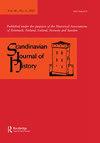Food availability and population growth in 17th century Sweden
IF 0.8
3区 历史学
Q1 HISTORY
引用次数: 1
Abstract
ABSTRACT The debate on the demographic development in Sweden in the Early Modern Period has a long history. A significant topic concerns how many people in fact lived in the country during the 16th and 17th centuries. This article focuses on the 17th century but leaves aside the question of absolute population numbers or growth rates. Instead, I will try to estimate the availability of grain, a dominant factor determining and limiting population developments in the period. There is a general view among historians that domestic grain production in Sweden stagnated during the 17th century. In this article, I add my voice to those who hold this view . In itself, this could also indicate a stagnant population. However I will show, that domestic production was not the same thing as grain availability. Swedish scholars are unanimous that in c. 1700 the country had c. 1,300,000 inhabitants. Using new source material, I will show that Sweden’s foreign grain trade in that period could feed at least 300,000 more people than in c. 1630. Finally, I will try to set Sweden’s growing grain trade in context with other developments in Sweden during the period.17世纪瑞典的食物供应和人口增长
关于瑞典近代早期人口发展的争论由来已久。一个重要的话题是,在16世纪和17世纪,有多少人住在这个国家。这篇文章的重点是17世纪,但把绝对人口数量或增长率的问题放在一边。相反,我将尝试估计粮食的可用性,这是决定和限制这一时期人口发展的主要因素。历史学家普遍认为,瑞典的国内粮食生产在17世纪停滞不前。在这篇文章中,我加入了那些持这种观点的人的声音。这本身也可能表明人口停滞不前。然而,我要说明的是,国内产量和粮食供应不是一回事。瑞典学者一致认为,大约1700年,瑞典有大约130万居民。使用新的原始材料,我将展示瑞典在这一时期的对外粮食贸易可以比1630年多养活至少30万人。最后,我将把瑞典不断增长的粮食贸易与这一时期瑞典的其他发展联系起来。
本文章由计算机程序翻译,如有差异,请以英文原文为准。
求助全文
约1分钟内获得全文
求助全文
来源期刊

SCANDINAVIAN JOURNAL OF HISTORY
HISTORY-
CiteScore
1.10
自引率
20.00%
发文量
33
期刊介绍:
Scandinavian Journal of History presents articles on Scandinavian history and review essays surveying themes in recent Scandinavian historical research. It concentrates on perspectives of national historical particularities and important long-term and short-term developments. The editorial policy gives particular priority to Scandinavian topics and to efforts of placing Scandinavian developments into a larger context. Studies explicitly comparing Scandinavian processes and phenomena to those in other parts of the world are therefore regarded as particularly important. In addition to publishing articles and review essays, the journal includes short book reviews. Review essay proposals and polemical communications are welcomed.
 求助内容:
求助内容: 应助结果提醒方式:
应助结果提醒方式:


